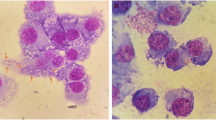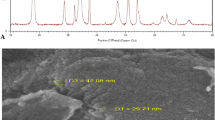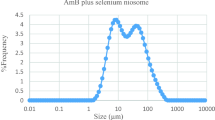Abstract
Leishmania infantum is one of the important causes of visceral leishmaniasis in many countries. There are different complications for treatment of leishmaniasis such as toxicity and drug resistant. So far, there isn’t any information about the effects of selenium nanoparticles and selenium dioxide (chemical form of selenium) on Leishmania parasites; hence, the aim of the present study is to investigate in vitro effects of six dilutions of these drugs on L. infantum. Anti-leishmanial activities were studied by adding different dilutions of 2.5, 5, 10, 25, 50, and 100 μg/ml of the drugs into promastigote cultures. Promastigote cytotoxicity was tested using the colorimetric MTT assay. Anti-amastigote activity was assessed in peritoneal macrophages of BALB/c mice. Also, cytotoxic effect of these drugs was evaluated on uninfected macrophages. The results showed that both of drugs have dose-dependent anti-leishmanial activities. Selenium NPs have more growth-inhibitory effect on promastigotes than SeO2; while the IC50 (50 % inhibitory concentration) was determined to be 25 and 50 μg/ml, respectively. The mean numbers of amastigotes per macrophage in selenium NPs-treated groups were less than SeO2-treated and control groups. The IC50 of selenium NPs was 10 μg/ml and SeO2 was 25 μg/ml for amastigotes. Also, the IC50 of selenium NPs and SeO2 for uninfected macrophages were calculated to be 100 and 50 μg/ml, respectively. In addition, selenium NPs has less cytotoxic effect than SeO2 on uninfected macrophages. These findings suggest that selenium NPs have more anti-leishmanial properties and less cytotoxic effects than SeO2 against L. infantum.




Similar content being viewed by others
Abbreviations
- Selenium NPs:
-
Selenium nanoparticles
- SeO2 :
-
Selenium dioxide
References
Aït-Oudhia K, Gazanion E, Vergnes B, Oury B, Sereno D (2011) Leishmania antimony resistance: what we know what we can learn from the field. Parasitol Res 109(5):1225–1232
Allahverdiyev AM, Abamor ES, Bagirova M, Ustundag CB, Kaya C, Kaya F, Rafailovich M (2011) Antileishmanial effect of silver nanoparticles and their enhanced antiparasitic activity under ultraviolet light. Int J Nanomedicine 6:2705–2714
Chappuis F, Sundar S, Hailu A, Ghalib H, Rijal S, Peeling RW, Alvar J, Boelaert M (2007) Visceral leishmaniasis: what are the needs for diagnosis, treatment and control? Nat Rev Microbiol 5(11):873–882
Chen WX, Cao XZ, Zhu RZ (2003) Effect of selenium dioxide on proliferation, apoptosis, and elomerase activity of human lung cancer cell line in vitro (in Chinese with English abstract). Chinese J Cancer 22(9):927–931
Croft SL, Sundar S, Fairlamb AH (2006) Drug resistance in leishmaniasis. Clin Microbiol Rev 19(1):111–126
Durand R, Paul M, Rivollet D, Houin R, Astier A, Deniau M (1997a) Activity of pentamidine-loaded methacrylate nanoparticles against Leishmania infantum in a mouse model. Int J Parasitol 27(11):1361–1367
Durand R, Paul M, Rivollet D, Fessi H, Houin R, Astier A, Deniau M (1997b) Activity of pentamidine-loaded poly (d,l-lactide) nanoparticles against Leishmania infantum in a murine model. Parasite 4(4):331–336
Fusai T, Deniau M, Durand R, Bories C, Paul M, Rivollet D, Astier A, Houin R (1994) Action of pentamidine-bound nanoparticles against Leishmania on an in vivo model. Parasite 1(4):319–324
GuanYi H, Ying Z, Qiang Z, Bin Z, LongPing (2010) Vacuolization and apoptosis induced by nano-selenium in HeLa cell line. Sci China Chem 53(11):2272–2278
Guerin PJ, Olliaro P, Sundar S, Boelaert M, Croft SL, Desjeux P, Wasunna MK, Bryceson AD (2002) Visceral leishmaniasis: current status of control, diagnosis, and treatment, and a proposed research and development agenda. Lancet Infect Dis 2(8):494–501
Huang B, Zhang J, Hou J, Chen C (2003) Free radical scavenging efficiency of Nano-Se in vitro. Free Radic Biol Med 35(7):805–813
Irache JM, Esparza I, Gamazo C, Agüeros M, Espuelas S (2011) Nanomedicine: novel approaches in human and veterinary therapeutics. Vet Parasitol 180(1–2):47–71
Kim BY, Rutka JT, Chan WC (2010) Nanomedicine. N Engl J Med 363(25):2434–2443
Kuppusamy UR, Wan YP, Chai JW, Kanthimathi MS, Kanthimathi MS, Kuppusamy UR (2005) A comparison between selenium dioxide and selenium methionine induced cytotoxicity in estrogen receptor negative and positive breast cancer cell lines. J Food Technol 3:269–273
Maltezou HC (2010) Drug resistance in visceral leishmaniasis. J Biomed Biotechnol 1–8. doi:10.1155/2010/617521
Mohebali M, Rezayat MM, Gilani K, Sarkar S, Akhoundi B, Esmaeili J, Satvat T, Elikaee S, Charehdar S, Hooshyar H (2009) Nanosilver in the treatment of localized cutaneous leishmaniasis caused by Leishmania major (MRHO/IR/75/ER): an in vitro and in vivo study. DARU 17(4):285–289
Murray HW, Berman JD, Davies CR, Saravia NG (2005) Advances in leishmaniasis. Lancet 366:1561–1577
Paris C, Loiseau PM, Bories C, Bréard J (2004) Miltefosine induces apoptosis-like death in Leishmania donovani promastigotes. Antimicrob Agents Chemother 48(3):852–859
Rayman MP (2012) Selenium and human health. Lancet 379(9822):1256–1268
Shakibaie M, Khorramizadeh MR, Faramarzi MA, Sabzevari O, Shahverdi AR (2010) Biosynthesis and recovery of selenium nanoparticles and the effects on matrix metalloproteinase-2 expression. Biotechnol Appl Biochem 56(1):7–15
Torabi N, Mohebali M, Shahverdi AR, Rezayat SM, Edrissian GH, Esmaeili J, Charehdar S (2011) Nanogold for the treatment of zoonotic cutaneous leishmaniasis caused by Leishmania major (MRHO/IR/75/ER): an animal trial with methanol extract of Eucalyptus camaldulensis. JPHS 1:13–16
Torres-Santos EC, Rodrigues JM, Moreira DL, Kaplan MA, Rossi-Bergmann B (1999) Improvement of in vitro and in vivo antileishmanial activities of 2', 6'-dihydroxy-4'-methoxychalcone by entrapment in poly (d, l-lactide) nanoparticles. Antimicrob Agents Chemother 43(7):1776–1778
Tran PA, Webster TJ (2011) Selenium nanoparticles inhibit Staphylococcus aureus growth. Int J Nanomedicine 6:1553–1558
Verma NK, Dey CS (2004) Possible mechanism of miltefosine-mediated death of Leishmania donovani. Antimicrob Agents Chemother 48(8):3010–3015
Wang H, Wei W, Zhang SY, Shen YX, Yue L, Wang NP, Xu SY (2005) Melatonin-selenium nanoparticles inhibit oxidative stress and protect against hepatic injury induced by Bacillus Calmette-Guérin/lipopolysaccharide in mice. J Pineal Res 39(2):156–163
Wang H, Zhang J, Yu H (2007) Elemental selenium at nano size possesses lower toxicity without compromising the fundamental effect on selenoenzymes: comparison with selenomethionine in mice. Free Radic Biol Med 42(10):1524–1533
Yousefi R, Ghaffarifar F, Dalimi Asl A (2009) The effect of Alkanna tincturia and Peganum harmala extracts on Leishmania major (MRHO/IR/75/ER) in vitro. Iranian J Parasitol 4(1):40–47
Zampa MF, Araújo IM, Costa V, Nery Costa CH, Santos JR Jr, Zucolotto V, Eiras C, Leite JR (2009) Leishmanicidal activity and immobilization of dermaseptin 01 antimicrobial peptides in ultrathin films for nanomedicine applications. Nanomedicine 5(3):352–358
Zhang J, Wang H, Bao Y, Zhang L (2004) Nano red elemental selenium has no size effect in the induction of seleno-enzymes in both cultured cells and mice. Life Sci 75(2):237–244
Zhang J, Wang H, Yan X, Zhang L (2005) Comparison of short-term toxicity between Nano-Se and selenite in mice. Life Sci 76(10):1099–1109
Author information
Authors and Affiliations
Corresponding author
Rights and permissions
About this article
Cite this article
Soflaei, S., Dalimi, A., Abdoli, A. et al. Anti-leishmanial activities of selenium nanoparticles and selenium dioxide on Leishmania infantum . Comp Clin Pathol 23, 15–20 (2014). https://doi.org/10.1007/s00580-012-1561-z
Received:
Accepted:
Published:
Issue Date:
DOI: https://doi.org/10.1007/s00580-012-1561-z




